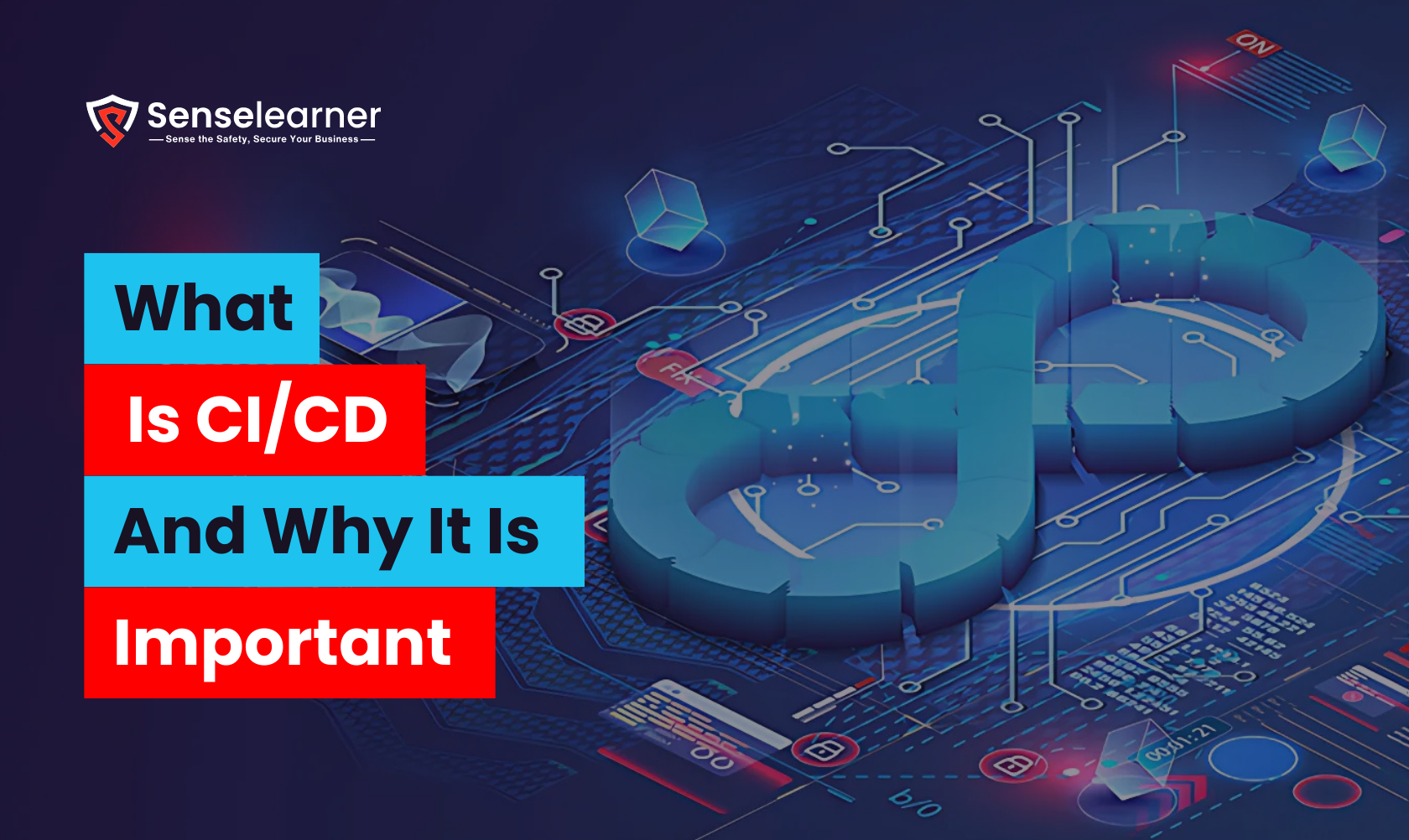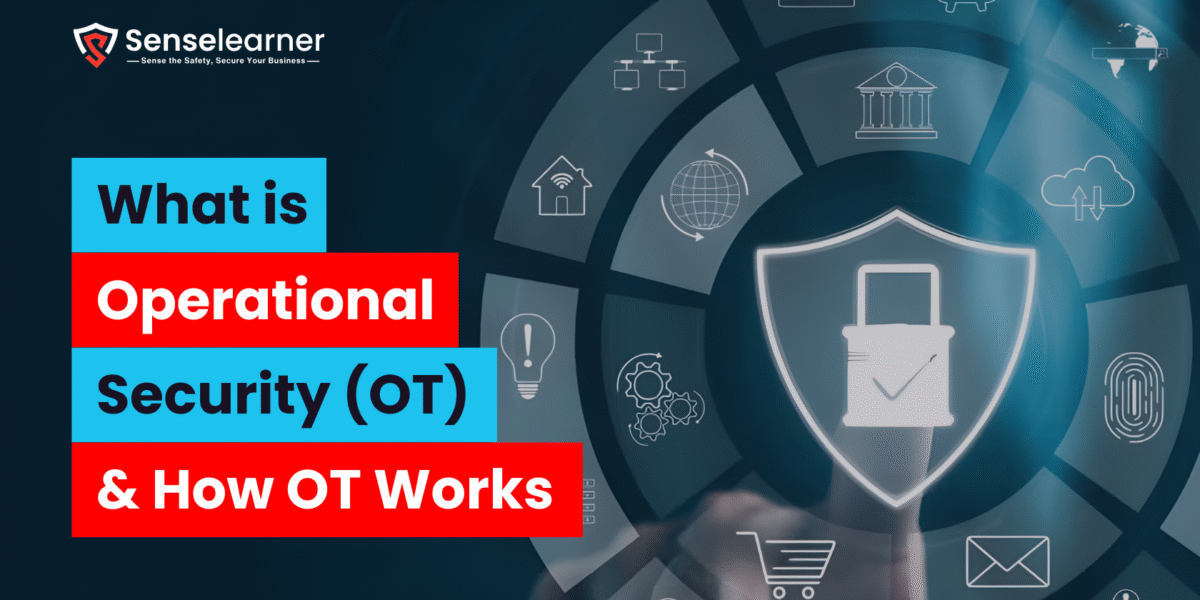Table of Contents
What is CI/CD
CI/CD stands for continuous integration and continuous delivery/continuous deployment. In very normal terms, CI (continuous integration) is a modern software development preparation in which incremental code variations are prepared often and dependably. Automatic construct-and-test phases initiated by CI (continuous integration) confirm that code variations being complex into the repository are dependable.
The code is then provided rapidly and flawlessly as a portion of the CD (continuous delivery/continuous deployment) procedure. In the software world, the CI/CD continuous integration and continuous delivery/continuous deployment pipeline denotes to the automation that allows incremental code variations from developers’ desktops to be brought rapidly and dependable to creation.
Why is CI/CD important?
In today’s fast-paced technical scenery, CI/CD (Continuous Integration and Continuous Delivery) are more than just industry slogans—they signify a critical foundation for a new software development procedure. CI/CD (Continuous Integration and Continuous Delivery) is essential because it automates the software development procedure, from coding over deployment.
This mechanization means crews can discharge new types and repairs quicker and more regularly, increasing the creation’s receptiveness to consumer wants. By unceasingly mixing and deploying, mistakes are discovered sooner, decreasing downtime and enlightening software worth.
CI/CD (Continuous Integration and Continuous Delivery) also permits for faster feedback loops with stakeholders, confirming that the final creation bring into line carefully with user prospects. Overall, it’s a foundational preparation for any team targeting for high-speed, high-worth software development.
Difference between CI and CD
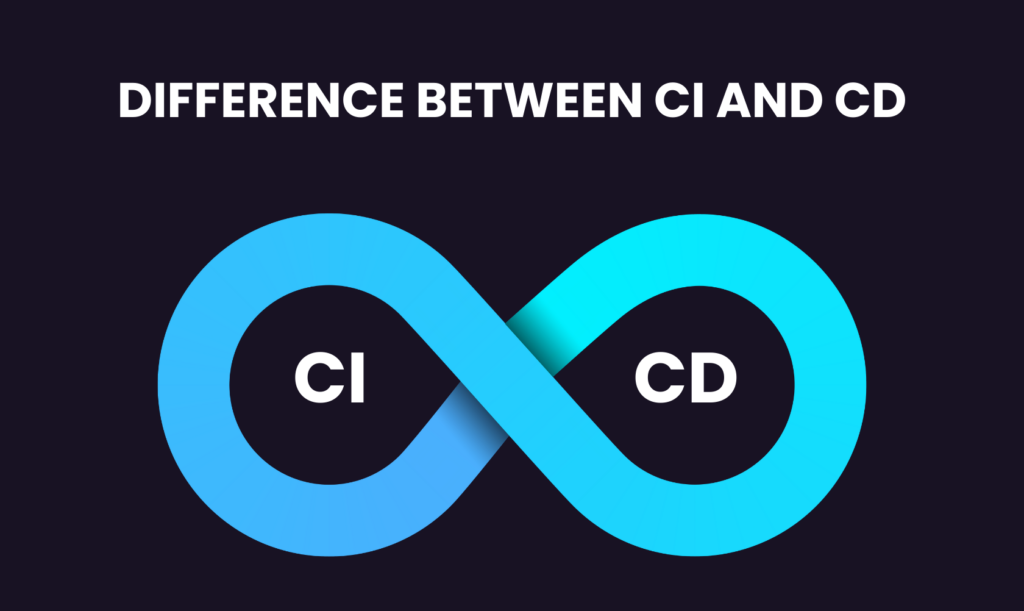
| Aspect | Continuous Integration (CI) | Continuous Delivery (CD) | Continuous Deployment |
| Definition | Developers frequently integrate small code changes into a shared repository. | Automates the delivery of tested code to development, testing, or staging environments. | Automatically deploys every successful code change to production without manual intervention. |
| Automation Level | Automates building, testing, and packaging of applications. | Ensures code is consistently delivered to various environments. | Fully automates the release process, pushing updates directly to users. |
| Primary Benefit | Speeds up development by detecting issues early. | Reduces manual work and ensures reliable software delivery. | Enables rapid updates, improving software agility. |
| Testing Process | Automated testing is performed to catch errors early. | Further testing in staging or pre-production environments. | Must pass all automated tests before deployment. |
| Deployment | Not directly involved in deployment. | Code is ready for deployment but requires manual approval. | Deploys changes to production automatically. |
| Best For | Teams looking to improve collaboration and code quality. | Organizations needing a controlled release process. | Companies aiming for continuous software updates without delays. |
12 Key Benefits of CI/CD
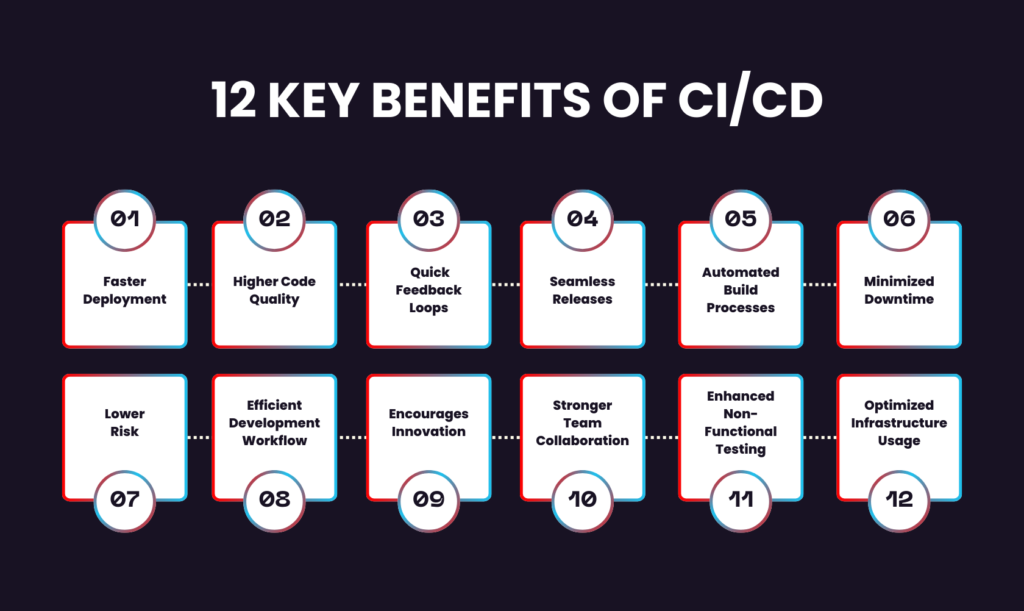
- Faster Deployment
CI/CD accelerates software releases by automating integration and delivery processes. Frequent updates allow businesses to respond quickly to user needs and market changes. This continuous flow of improvements enhances customer satisfaction and competitiveness. Automation ensures that updates are tested and deployed with minimal delays.
- Higher Code Quality
Automated testing is integrated into the CI/CD pipeline, identifying errors early in development. This reduces the chances of defects reaching production, ensuring stable and reliable software. With consistent testing, developers can focus on writing better code instead of fixing recurring issues. Over time, this leads to more maintainable and high-quality applications.
- Quick Feedback Loops
CI/CD enables developers to receive real-time feedback after each code commit. Immediate alerts about issues allow for faster troubleshooting and resolution. This minimizes the time spent switching between tasks and improves overall productivity. Rapid feedback helps teams iterate efficiently and refine their code continuously.
- Seamless Releases
Automation eliminates the challenges of manual deployments, making releases smoother and more predictable. CI/CD ensures each release follows a structured and repeatable process, reducing human errors. Teams can roll out updates confidently without service disruptions. This consistency transforms deployments from stressful events into routine operations.
- Automated Build Processes
CI/CD automates the process of compiling, testing, and packaging applications. This eliminates manual intervention, saving time and reducing the risk of mistakes. Automated builds ensure consistency across development, testing, and production environments. As a result, software is deployed faster and with greater reliability.
- Minimized Downtime
With smaller, frequent updates, it’s easier to isolate and fix issues before they cause major disruptions. Quick rollbacks or hotfixes can be implemented without impacting the entire system. Automated testing reduces the likelihood of deploying faulty code to production. This results in more stable applications and improved user experience.
- Lower Risk
Regularly releasing small updates makes it easier to detect problems early in the development cycle. Instead of waiting months for a major release, teams can test and validate features continuously. This reduces the risk of costly rework and major failures post-launch. Businesses can experiment safely and optimize their products over time.
- Efficient Development Workflow
CI/CD encourages developers to commit small code changes frequently, preventing integration issues. Smaller commits simplify code reviews and make debugging more manageable. This leads to a more structured and collaborative development process. Teams can integrate new features faster without disrupting on-going work.
- Encourages Innovation
By automating repetitive tasks, CI/CD frees up time for developers to focus on innovation. Instead of performing manual tests, engineers can explore new solutions and improve software functionality. QA teams can dedicate efforts to uncovering edge cases rather than routine checks. This results in more creative problem-solving and higher-quality products.
- Stronger Team Collaboration
CI/CD fosters better cooperation between development, security, and operations teams. Shared pipelines and transparent processes improve communication and streamline workflows. With better visibility, teams can resolve dependencies and conflicts faster. This collaborative approach leads to faster development cycles and higher efficiency.
- Enhanced Non-Functional Testing
CI/CD makes it easier to automate security, performance, and compliance testing. Deploying changes to dedicated testing environments ensures that all non-functional aspects are validated. This is particularly beneficial for industries with strict regulatory requirements. Regular testing helps maintain system integrity and user trust.
- Optimized Infrastructure Usage
CI/CD enables infrastructure-as-code, allowing teams to manage servers programmatically. Automated scaling ensures resources are allocated efficiently based on demand. This prevents unnecessary costs while maintaining optimal performance. As a result, businesses can maximize efficiency without over spending on infrastructure.
What are some common CI/CD tools?
CI/CD tools can assists a crew automate their testing, deployment and development. Some tools exactly handle the integration continuous integration (CI) side; some accomplish development and deployment continuous deployment (CD), while others specify in continuous testing or associated purposes.
Tekton Pipelines is a continuous integration and continuous delivery/continuous deployment CI/CD outline for Kubernetes stages that delivers a normal cloud-native CI/CD knowledge with containers.
Explore more about Tekton Pipelines
Beyond Tekton Pipelines, other open source continuous integration and continuous delivery/continuous deployment CI/CD utensils you might wish to examine contain:
- Jenkins, intended to grip whatever from a simple continuous integration (CI )server to a whole continuous delivery/continuous deployment CD hub
- Spinnaker, a continuous delivery/continuous deployment CD stage constructed for multicloud atmospheres.
- GoCD, a continuous integration and continuous delivery/continuous deployment CI/CD server with an importance on modeling and imagining.
- Concourse, “an open-source nonstop object-doer.”
- Screwdriver, a form stage intended for continuous delivery/continuous deployment CD.
Crews might also need to reflect accomplished continuous integration and continuous delivery/continuous deployment CI/CD tools, which are accessible from a diversity of vendors. The main public cloud suppliers all deal continuous integration and continuous delivery/continuous deployment CI/CD results, beside with Atlassian Bamboo, Travis CI, CircleCI, GitLab and various others.
CI/CD vs. DevOps: Key Differences
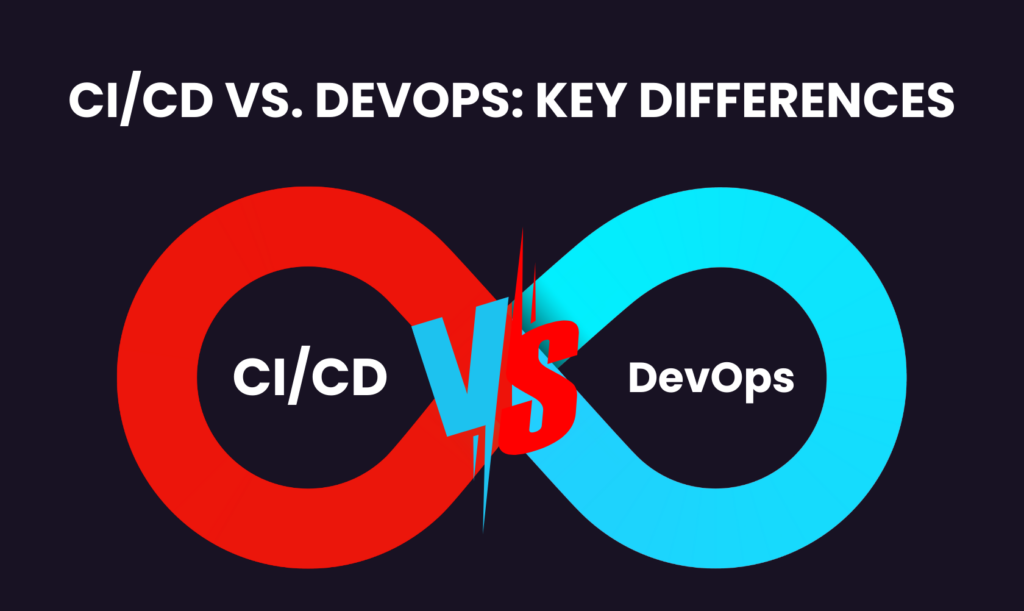
| Aspect | CI/CD (Continuous Integration & Continuous Deployment) | DevOps |
| Definition | CI/CD focuses on automating the software development lifecycle, including integration, testing, and deployment. | DevOps is a broader culture that combines development and operations to improve collaboration and efficiency. |
| Scope | Primarily concerned with the automation of software delivery processes. | Covers the entire software development lifecycle, including planning, coding, building, testing, deployment, monitoring, and security. |
| Goal | To streamline code integration, testing, and deployment, ensuring frequent and reliable releases. | To improve collaboration between development and operations teams for faster, more stable, and secure software delivery. |
| Automation Focus | Automates code building, testing, and deployment pipelines. | Automates infrastructure provisioning, monitoring, and security along with CI/CD. |
| Key Practices | Continuous Integration (CI), Continuous Delivery (CD), and Continuous Deployment. | Infrastructure as Code (IaC), Configuration Management, Monitoring, CI/CD, and Incident Management. |
| Tools Used | Jenkins, GitLab CI/CD, CircleCI, Travis CI, Bamboo. | Docker, Kubernetes, Terraform, Ansible, Prometheus, and CI/CD tools. |
| Team Focus | Primarily used by development and testing teams. | Encourages collaboration between development, operations, security, and business teams. |
| Infrastructure Management | Not a core focuses; relies on DevOps practices for infrastructure automation. | Emphasizes infrastructure automation, containerization, and cloud computing. |
| Speed & Efficiency | Increases deployment speed by automating integration, testing, and release processes. | Enhances overall efficiency by reducing silos between teams and optimizing workflows. |
| End Goal | Ensures fast, automated, and reliable software delivery. | Establishes a culture of collaboration, automation, and continuous improvement. |
How Senselearner can help
Our specialists can assist your association grow the practices, utensils, and nation required to more proficiently update current requests and hurry your cloud-native request development journey.
Senselearner Open Shift assists administrations progress designer efficiency, automate continuous integration and continuous delivery/continuous deployment CI/CD pipelines, and shift their safety efforts previous and through the development series. Senselearner Open Shift Pipelines is intended to track each phase of the CI/CD pipeline in its own container, letting all stages to measure freely to encounter the demands of the pipeline. This means managements and designers can make pipeline outlines for requests that are founded on their administration’s exclusive business and safety necessities.
Senselearner Open Shift GitOps is an operator that delivers a workflow that assimilates git sources, (CI/CD) utensils, and Kubernetes to understand quicker, safer, accessible software development, without conceding worth. OpenShift GitOps allows clients to form and assimilate declarative git driven continuous delivery/continuous deployment (CD) workflows straight into their request growth platform.
Senselearner Ansible Automation Platform contains all the utensils you requisite to appliance automation through your society, counting an event-driven explanation, analytics, and pre-constructed content gatherings. With its mutual YAML-centred language and wanted-state method, you can use the same automation content for ordinary processes as well as your continuous integration and continuous delivery/continuous deployment CI/CD pipeline. And because it works with closely all features of your IT organization, you can more simply and rapidly deploy reliable development, test, and manufacture atmospheres, growing the dependability and resiliency of your requests.
Ansible Automation Platform also assimilates with Senselearner Cutting-edge Cluster Organization for Kubernetes, letting you to orchestrate Kubernetes clusters within your continuous integration and continuous delivery/continuous deployment CI/CD pipeline. You can also use the human-legible automation linguistic to extra simply form and preserve Senselearner OpenShift workers.
Explore More: 5 pillars of SaaS security: That you must know
FAQ
How does CI/CD improve software quality?
CI/CD integrates automated testing at every stage of development, identifying bugs early and ensuring stable, error-free releases. It also enforces best practices, reducing security and performance risks.
How does CI/CD reduce deployment risks?
By deploying smaller, more frequent updates, CI/CD makes it easier to isolate and fix issues. Automated rollback features allow quick recovery from failed deployments.
What tools are commonly used for CI/CD?
Popular CI/CD tools include Jenkins, GitLab CI/CD, CircleCI, Travis CI, Bamboo, and AWS Code Pipeline. These tools help automate build, test, and deployment processes.
How does CI/CD support DevOps?
CI/CD is a fundamental practice in DevOps, promoting automation, collaboration, and continuous improvement between development and operations teams for faster and more stable software releases.
What are the challenges of implementing CI/CD?
Challenges include initial setup complexity, choosing the right tools, maintaining security, and ensuring proper test coverage. However, once established, CI/CD significantly improves development efficiency.
